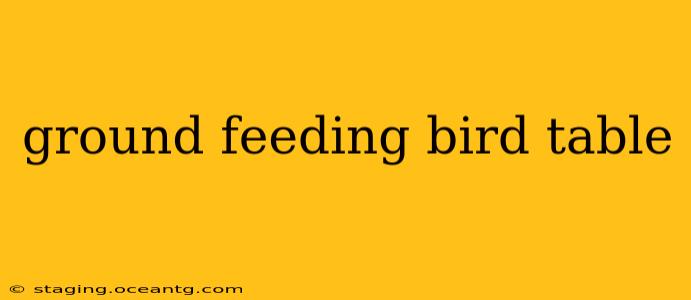Ground feeding bird tables offer a fantastic way to attract a wider variety of birds to your garden, especially those species less comfortable perched high on traditional feeders. This guide will explore the benefits, considerations, and best practices for setting up and maintaining a ground feeding station, answering many frequently asked questions along the way.
What are the benefits of a ground feeding bird table?
Ground feeders offer several advantages over hanging feeders. Firstly, they cater to species like robins, sparrows, blackbirds, and dunnocks that prefer foraging on the ground. Secondly, they provide a safer feeding area for birds less adept at navigating hanging feeders or vulnerable to aerial predators. Finally, they allow for easy observation of bird behaviour at ground level, offering a closer and more intimate wildlife viewing experience.
What types of birds are attracted to ground feeders?
Many species benefit from ground feeding stations. You’re likely to attract ground-feeding birds such as:
- Robins: Known for their bright red breasts and cheerful song.
- Sparrows: Various sparrow species will readily visit a ground feeder.
- Blackbirds: These large, black birds are frequent visitors to gardens.
- Dunnock (Hedge Accentor): Small, brown birds often found foraging on the ground.
- Wrens: These tiny, active birds will enjoy foraging on the ground near cover.
- Starlings: Although they can also use other feeders, starlings frequently visit ground feeders.
Remember, the specific birds attracted will depend on your location and the types of food you provide.
What kind of food should I use in a ground feeder?
The best food for a ground feeding bird table is varied to attract a diverse range of species. Consider offering:
- Seeds: Sunflower seeds (black oil sunflower seeds are a favorite), nyjer seeds, and mixed seed blends.
- Crumbled bread: A small amount of stale bread can be a supplementary food source, but avoid feeding large quantities or moldy bread.
- Suet: Suet pellets or blocks offer high-energy food, especially beneficial during colder months.
- Mealworms: Dried or live mealworms are a protein-rich treat that many birds adore.
- Fruit: Pieces of apple, berries, or grapes can attract different species.
Always ensure the food is fresh and free from mold or contamination.
How do I prevent food waste and attract fewer pests?
Preventing waste and deterring pests is crucial for maintaining a clean and effective ground feeding station. Consider these tips:
- Use a shallow, wide feeder: This allows easy access for birds while minimizing spillage.
- Regular cleaning: Clean the feeder regularly to remove old food, droppings, and prevent the spread of disease.
- Choose the right location: Place the feeder away from overhanging branches or bushes where pests can easily hide.
- Use a feeder with a base: A feeder with a raised base or tray helps prevent scattering of seeds.
- Supplement with other feeding methods: By diversifying your feeding strategies, you will reduce over-reliance on the ground feeder.
What is the best location for a ground feeding bird table?
Placement is key to maximizing bird activity and minimizing waste. Ideally, your ground feeder should be:
- In a relatively open area: This allows birds to approach safely and easily spot potential predators.
- Close to cover: Nearby shrubs or bushes provide refuge for birds from aerial predators and offer a place to escape if threatened.
- Away from direct sunlight: Sunlight can cause food to spoil more quickly.
- Accessible for cleaning: Choose a spot that's easy to reach for regular cleaning.
How often should I clean a ground feeding bird table?
Regular cleaning is essential to maintain hygiene and prevent the spread of disease among birds. Aim to clean your ground feeder at least once a week, or more frequently if the weather is particularly wet or humid. Remove any spoiled food, droppings, and debris. Washing with warm soapy water and rinsing thoroughly is recommended.
By following these tips and selecting the right type of feeder and food, you can create a thriving ground feeding bird table that attracts a variety of birds to your garden, providing endless hours of enjoyable birdwatching. Remember, responsible feeding practices are crucial for the health and well-being of your feathered visitors.
